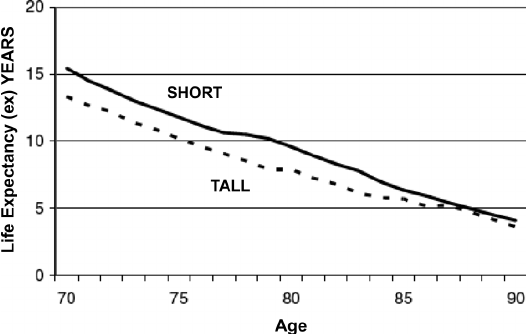It has been observed in nature that larger-bodied animals tend to live much longer lives than smaller ones (Hutchings, 2021). Compare the maximal lifespan of a Greenland whale (over 200 years) to that of the house mouse (four years) and you will see what I am getting at. However, nature isn’t without its exceptions and lifespan varies among animal classes and kingdoms. Reptiles do, for example, tend to live longer than similar sized mammals (de Magalhães, 2023; Shilovsky et al., 2022). This may be partially due to them having a slower metabolic rate. A slower metabolic rate puts less strain on the body and reduces several aspects of ageing, such as oxidative stress (Redman et al., 2018). However, there also exist differences among and within species (Tyshkovskiy et al., 2023). Dogs, humankind’s perhaps most adaptable pet, come in many shapes and sizes and it’s also been observed that smaller dogs live longer lives than bigger breeds, which is the inverse of a larger body size predicting longevity (Yordy et al., 2020). Thus, the relationship between longevity and body size is not that simple but rather a result of many varying factors.
In humans there is less certainty whether a person’s body size is beneficial or detrimental to achieving longevity (Gunnell et al., 2001; Chmielewski, 2023). A person’s body size is a result of several factors, including genes but also access to nutrition and their sex. At the same time a greater height is seen as being an advantage socially with taller people often enjoying privileges (Stulp et al., 2015). Still, being tall has been found to be associated with a higher prevalence of some conditions, including atrial fibrillation and venous thromboembolism (Krieg et al., 2022). At the same time, a smaller stature is associated with a higher risk of developing coronary heart disease and hypertension (Nüesch et al., 2016). Concerning longevity there are mixed results. Chmielewski (2023) has observed that taller people in Poland have a disadvantage in lifespan. Some researchers have noted that taller people have a lower mortality than their shorter peers at younger ages but that this changes over the age of 70 (Samaras, 2012). Salaris et al. (2012) observed that among a group of elderly men living on Sardinia shorter men lived two years longer on average.
Most interestingly perhaps, are studies on centenarians. It has been observed that centenarians are generally shorter and lighter than the people that die at ages 80-99 (Fu et al., 2021; Roth et al., 1995). Martinez et al. (2009) noted that Cuban male centenarians only were just over five feet on average and a study on Japanese centenarians in Okinawa noted that they were even shorter (Chan et al., 1997). Similarly, a Chinese study noted that female centenarians were on average 143 centimeters tall (Fu et al., 2021).
It must however be noted that a person’s height decreases as they age (Fernihough & McGovern, 2015). This is partially associated with a person’s socioeconomic status (Huang et al., 2013). A Polish study reported that the decrease in height between the ages of 50 and 100 were over 13 centimeters for both female and male centenarians (Broczek et al., 2005). Other researchers are more conservative in their results of height loss during the lifespan (Wannamethee et al., 2006; Huang et al., 2013). However, few studies have focused on centenarians and shrinkage at such advanced ages.

Narcissa Rickman her 108th birthday in 1963. (Source: The Asheville Times)
What about supercentenarians?
As would be expected, people who live longer than 110 years are often very short. One of the shortest supercentenarians on record was Narcissa Rickman (1855–1968), who was reported to only have been about four feet tall. Most female supercentenarians with reliable health records have reported their height in their younger days to have been around five feet. Similarly, few male supercentenarians have been reported to have stood taller than six feet. The tallest supercentenarian that I know of is Melvin Campbell (1910–2021) who was about 191 centimeters (over 6’2″) when he was drafted for World War II.
What have we learned?
If you want to live a longer life it is beneficial if you are a bit shorter than average, especially if you want to become a centenarian. Both being tall and being short are, however, associated with a higher prevalence of certain chronic conditions which may lead to a slight risk of increased mortality. As a person ages they will experience a shrinkage in stature, exactly how much being dependent on several factors, including socioeconomic status. Few studies have focused on how much a person shrinks by the time they are a centenarian; the one I could find indicated that a person loses close to ten percent of their height from age 50 to 100. There’s unfortunately a lot of missing data about supercentenarian heights and research on this subject would probably be of great interest to potentially further demonstrate the relationship between body size and longevity.
References
Broczek, K. M., Pawlińska-Chmara, R., Kupisz-Urbańska, M., & Mossakowska, M. (2005). Anthropometric chest structure of Polish centenarians. Journal of physiology and pharmacology : an official journal of the Polish Physiological Society, 56 Suppl 4, 9–13.
Chan, Y. C., Suzuki, M., & Yamamoto, S. (1997). Dietary, anthropometric, hematological and biochemical assessment of the nutritional status of centenarians and elderly people in Okinawa, Japan. Journal of the American College of Nutrition, 16(3), 229–235. https://doi.org/10.1080/07315724.1997.10718679
Chmielewski P. P. (2023). The association between body height and longevity: evidence from a national population sample. Folia morphologica, 10.5603/FM.a2023.0005. Advance online publication. https://doi.org/10.5603/FM.a2023.0005
Fernihough, A., & McGovern, M. E. (2015). Physical stature decline and the health status of the elderly population in England. Economics and human biology, 16, 30–44. https://doi.org/10.1016/j.ehb.2013.12.010
Fu, S., Ping, P., Li, Y., Li, B., Zhao, Y., Yao, Y., & Zhang, P. (2021). Centenarian longevity had inverse relationships with nutritional status and abdominal obesity and positive relationships with sex hormones and bone turnover in the oldest females. Journal of translational medicine, 19(1), 436. https://doi.org/10.1186/s12967-021-03115-7
Gunnell, D., Rogers, J., & Dieppe, P. (2001). Height and health: predicting longevity from bone length in archaeological remains. Journal of Epidemiology and Community Health, 55(7), 505–507. https://doi.org/10.1136/jech.55.7.505
Huang, W., Lei, X., Ridder, G., Strauss, J., & Zhao, Y. (2013). Health, Height, Height Shrinkage, and SES at Older Ages: Evidence from China. American economic journal. Applied economics, 5(2), 86–121. https://doi.org/10.1257/app.5.2.86
Hutchings, J. A. (2021). A Primer of Life Histories: Ecology, Evolution and Application. Oxford University Press.
Krieg, S., Kostev, K., Luedde, M., Krieg, A., Luedde, T., Roderburg, C., & Loosen, S. H. (2022). The association between the body height and cardiovascular diseases: a retrospective analysis of 657,310 outpatients in Germany. European journal of medical research, 27(1), 240. https://doi.org/10.1186/s40001-022-00881-y
de Magalhães J. P. (2024). The longevity bottleneck hypothesis: Could dinosaurs have shaped ageing in present-day mammals?. BioEssays: news and reviews in molecular, cellular and developmental biology, 46(1), e2300098. https://doi.org/10.1002/bies.202300098
Nüesch, E., Dale, C., Palmer, T. M., White, J., Keating, B. J., van Iperen, E. P., Goel, A., Padmanabhan, S., Asselbergs, F. W., EPIC-Netherland Investigators, Verschuren, W. M., Wijmenga, C., Van der Schouw, Y. T., Onland-Moret, N. C., Lange, L. A., Hovingh, G. K., Sivapalaratnam, S., Morris, R. W., Whincup, P. H., Wannamethe, G. S., … Casas, J. P. (2016). Adult height, coronary heart disease and stroke: a multi-locus Mendelian randomization meta-analysis. International journal of epidemiology, 45(6), 1927–1937. https://doi.org/10.1093/ije/dyv074
Redman, L. M., Smith, S. R., Burton, J. H., Martin, C. K., Il’yasova, D., & Ravussin, E. (2018). Metabolic Slowing and Reduced Oxidative Damage with Sustained Caloric Restriction Support the Rate of Living and Oxidative Damage Theories of Aging. Cell metabolism, 27(4), 805–815.e4. https://doi.org/10.1016/j.cmet.2018.02.019
Roth, G. S., Ingram, D. K., & Lane, M. A. (1995). Slowing ageing by caloric restriction. Nature medicine, 1(5), 414–415. https://doi.org/10.1038/nm0595-414
Salaris, L., Poulain, M., & Samaras, T. T. (2012) Height and survival at older ages among males born in an inland village in Sardinia (1866–1915). Biodemography and Social Biology, 58(1), 1–13. https://doi.org/10.1080/19485565.2012.666118
Samaras, T. T. (2012). How height is related to our health and longevity: A review. Nutrition and Health, 21(4), 247–261. https://doi.org/10.1177/0260106013510996
Shilovsky, G. A., Putyatina, T. S., & Markov, A. V. (2022). Evolution of Longevity as a Species-Specific Trait in Mammals. Biochemistry. Biokhimiia, 87(12), 1579–1599. https://doi.org/10.1134/S0006297922120148
Stulp, G., Buunk, A. P., Verhulst, S., & Pollet, T. V. (2015). Human height is positively related to interpersonal dominance in dyadic interactions. PloS one, 10(2), e0117860. https://doi.org/10.1371/journal.pone.0117860
Tyshkovskiy, A., Ma, S., Shindyapina, A. V., Tikhonov, S., Lee, S. G., Bozaykut, P., Castro, J. P., Seluanov, A., Schork, N. J., Gorbunova, V., Dmitriev, S. E., Miller, R. A., & Gladyshev, V. N. (2023). Distinct longevity mechanisms across and within species and their association with aging. Cell, 186(13), 2929–2949.e20. https://doi.org/10.1016/j.cell.2023.05.002
Wannamethee, S. G., Shaper, A. G., Lennon, L., & Whincup, P. H. (2006). Height loss in older men: associations with total mortality and incidence of cardiovascular disease. Archives of internal medicine, 166(22), 2546–2552. https://doi.org/10.1001/archinte.166.22.2546
Yordy, J., Kraus, C., Hayward, J. J., White, M. E., Shannon, L. M., Creevy, K. E., Promislow, D. E. L., & Boyko, A. R. (2020). Body size, inbreeding, and lifespan in domestic dogs. Conservation genetics (Print), 21(1), 137–148. https://doi.org/10.1007/s10592-019-01240-x

